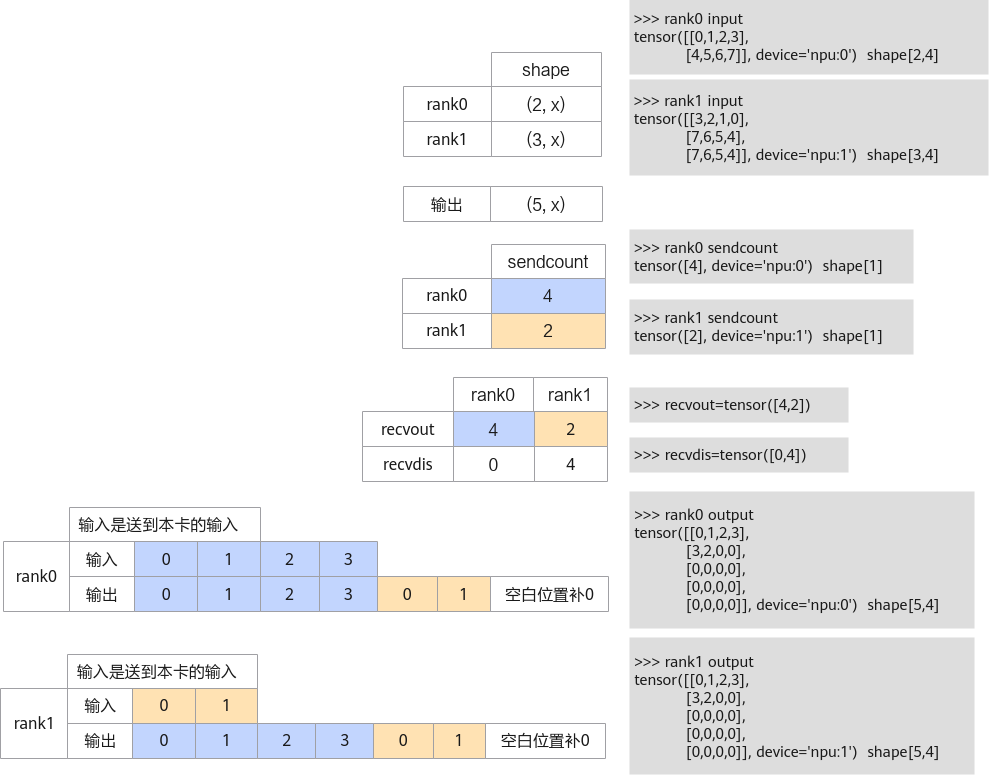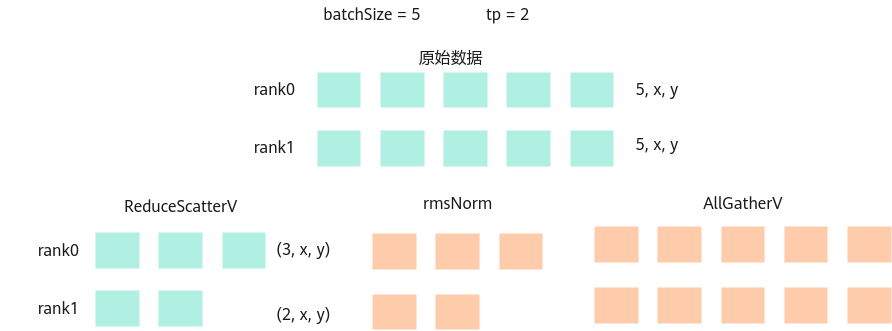功能
将多个通信卡上的数据按通信编号的顺序在第一维进行聚合,然后发送到每张卡上。支持每张卡发送的数据不等长。
推理场景中会出现batch size不能被DP数整除的情况,reducescatter后续的计算算子需要按照batch维度处理数据,再将处理数据进行allgather,如图图1所示。
示例:

计算过程示意(python):
# 计算goldtensor
gold_outtensor = []
for i in range(len(sendcount)):
gold_outtensor= gold_outtensor+(tensorafters[i][0:sendcount[i]])
GoldenTensors = (torch.tensor(np.array(gold_outtensor+[0]*(sum*dim[1]-len(gold_outtensor))).reshape(sum,dim[1]), dtype=inTensorDtype))
使用场景
模型并行;模型并行里前向计算里的参数全同步,需要用AllgatherV把模型并行里将切分到不同的XPU上的参数全同步到一张XPU上才能进行前向计算。
>>> rank0 input
tensor([[0,1,2,3],
[4,5,6,7]], device='npu:0') shape[2,4]
>>> rank0 sendcount
tensor([4], device='npu:0') shape[1]
>>> rank1 input
tensor([[3,2,1,0],
[7,6,5,4],
[7,6,5,4]], device='npu:1') shape[3,4]
>>> rank1 sendcount
tensor([2], device='npu:1') shape[1]
>>> recvout=tensor([4,2])
>>> recvdis=tensor([0,4])
>>> y=tensor([0,1,2,3,4], device='npu:0')
>>> rank0 output
tensor([[0,1,2,3],
[3,2,0,0],
[0,0,0,0],
[0,0,0,0],
[0,0,0,0]], device='npu:0') shape[5,4]
>>> rank1 output
tensor([[0,1,2,3],
[3,2,0,0],
[0,0,0,0],
[0,0,0,0],
[0,0,0,0]], device='npu:1') shape[5,4]
定义
1 2 3 4 5 6 7 8 9 10 11 | struct AllGatherVParam { int rank = -1; int rankSize = 0; int rankRoot = 0; std::string backend = "hccl"; HcclComm hcclComm = nullptr; CommMode commMode = COMM_MULTI_PROCESS; std::string rankTableFile; std::string commDomain; uint8_t rsv[64] = {0}; }; |
参数列表
成员名称 |
类型 |
默认值 |
描述 |
|---|---|---|---|
rank |
int |
-1 |
当前卡所属通信编号。-1表示未传。 |
rankSize |
int |
0 |
通信的卡的数量,不能为0。 |
rankRoot |
int |
0 |
主通信编号。 |
backend |
std::string |
"hccl" |
通信计算类型,仅支持"hccl"。 |
hcclComm |
HcclComm |
nullptr |
hccl通信域接口获取的地址指针。默认为空,加速库为用户创建;若用户想要自己管理通信域,则需要传入该通信域指针,加速库使用传入的通信域指针来执行通信算子。 |
commMode |
CommMode |
COMM_MULTI_PROCESS |
通信模式,CommMode类型枚举值。hccl多线程只支持外部传入通信域方式。
|
rankTableFile |
std::string |
- |
集群信息的配置文件路径,用于多机通信场景,当前仅支持hccl后端场景。集群信息的配置文件路径,适用单机以及多机通信场景,当前仅支持hccl后端场景,若单机配置了rankTable,则以ranktable来初始化通信域。 ranktable配置请参考:《TensorFlow 1.15模型迁移指南》的“模型训练>执行分布式训练>准备ranktable资源配置文件”章节。 |
commDomain |
std::string |
- |
通信device组用通信域名标识,多通信域时使用,当前仅支持hccl。 |
rsv[64] |
uint8_t |
{0} |
预留参数。 |
输入
参数 |
维度 |
数据类型 |
格式 |
是否必选 |
描述 |
|---|---|---|---|---|---|
x |
[dim_0, dim_1, ..., dim_n] |
"hccl": float16/int8/bfloat16 |
ND |
是 |
输入tensor。 |
sendCount |
1[1] |
int64 |
ND |
是 |
输入tensor,为本卡发送的数据量。支持每张卡的该tensor不同,即支持数据不等长。 |
recvCounts |
1[ranksize] |
int64 |
ND |
是 |
输入tensor,为从对应索引卡号接收到的数据量,每张卡都一样。 |
rdispls |
1[ranksize] |
int64 |
ND |
是 |
为从对应索引卡号接收到的数据量的偏移,每张卡都一样,rdispls[i] = n表示本rank从相对于输入起始位置的偏移量为n的位置开始接收rank_i的数据。 |
y |
1[每个卡的第1维的shape的和] |
float16 |
ND |
是 |
shape为所有卡的合并tensor的首shape之和,用于infer shape。 |
输出
参数 |
维度 |
数据类型 |
格式 |
是否必选 |
描述 |
|---|---|---|---|---|---|
output |
[n, dim_1, ..., dim_n] |
"hccl": float16/int8/bfloat16 |
ND |
否 |
输出tensor,与输入tensor地址不同,非原地写,n为所有卡的要合并tensor的第一维shape之和,即y的shape。数据类型和输入相同。 |
规格约束
- backend必须是hccl。
- 数组参数recvCounts、rdispls的长度等于ranksize。
- 卡rank的sendCount与recvCounts[rank]相等。
- out tensor第1维的shape等于y的shape。
- 仅支持
Atlas 推理系列产品 和Atlas 800I A2 推理产品 。 - 各个通信卡的输入tensor的第0维维度可不同,其它维维度需相同。
- recvCounts数组元素之和不能溢出int64,recvCounts的数组和要大于0。
- sendCount的值不能超过输入tensor x的所有维度的shape的乘积。
- rank、rankSize、rankRoot需满足以下条件。
- 0 ≤ rank < rankSize
- 0 ≤ rankRoot < rankSize
